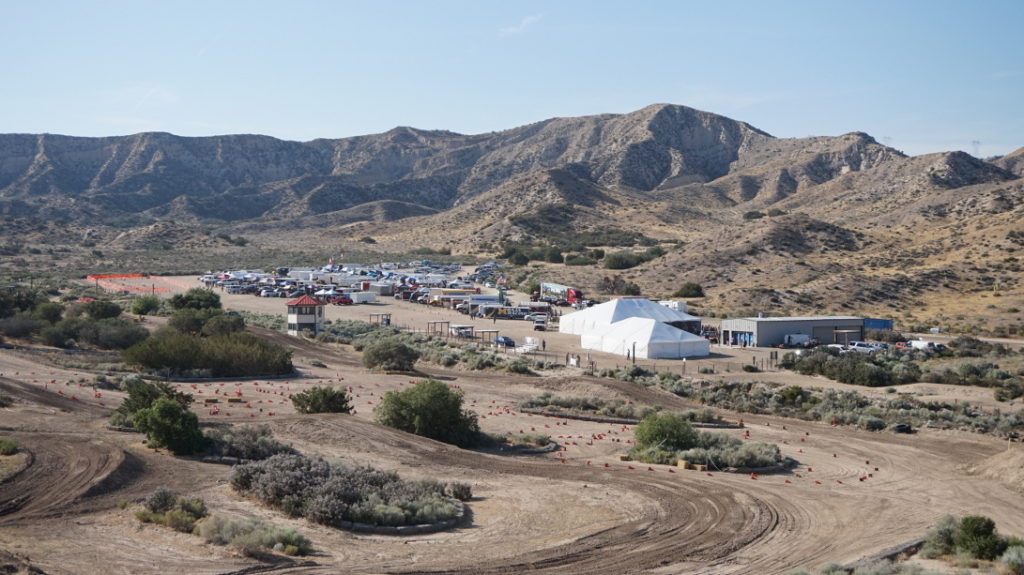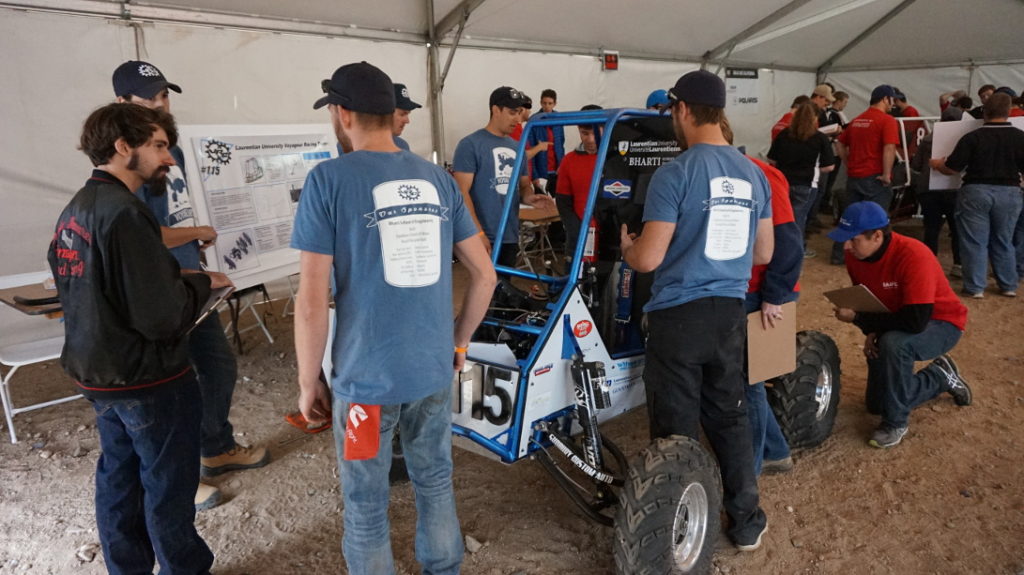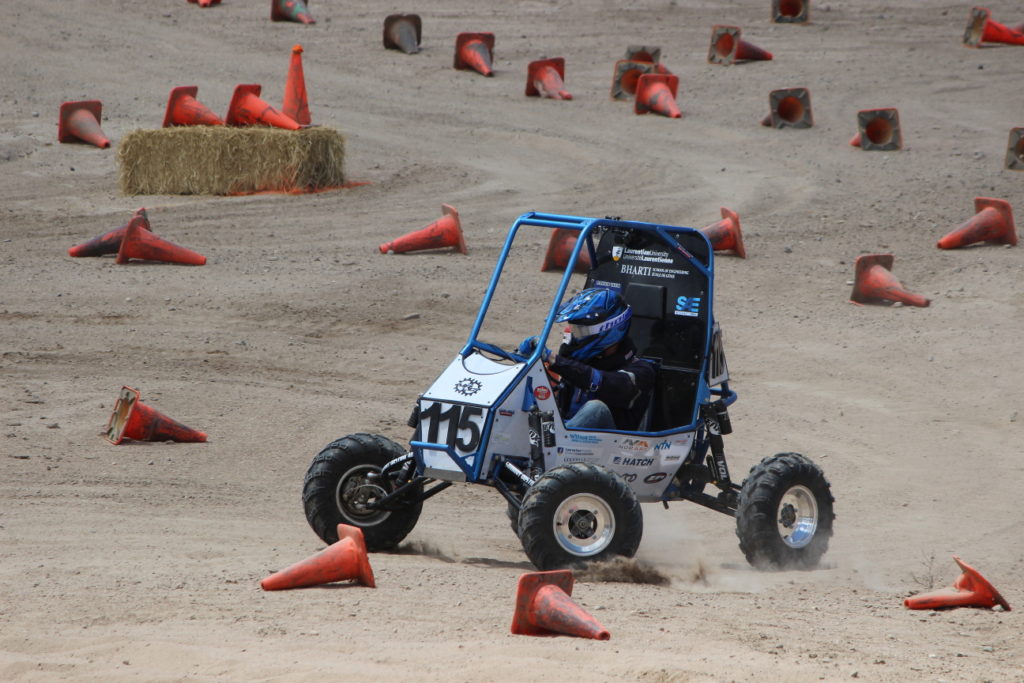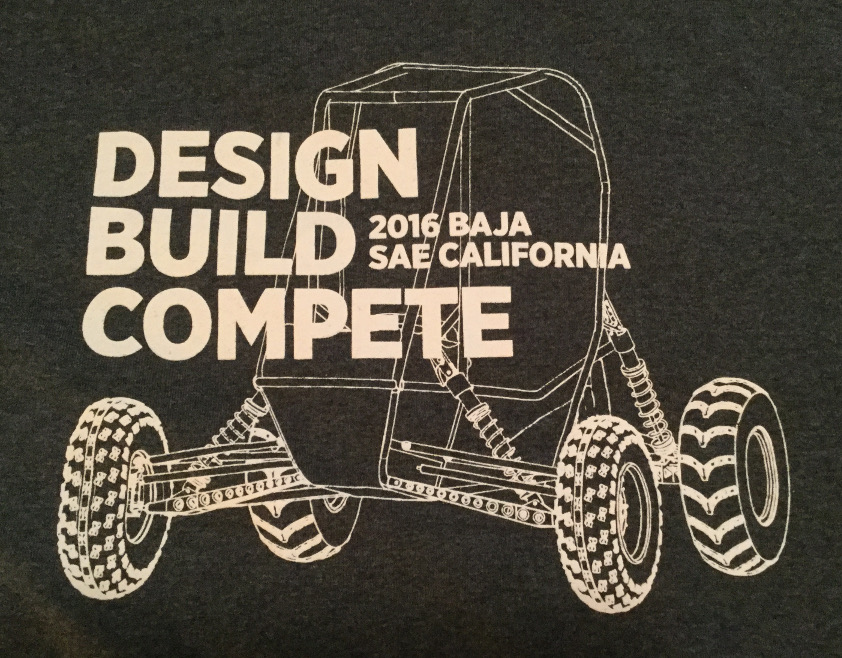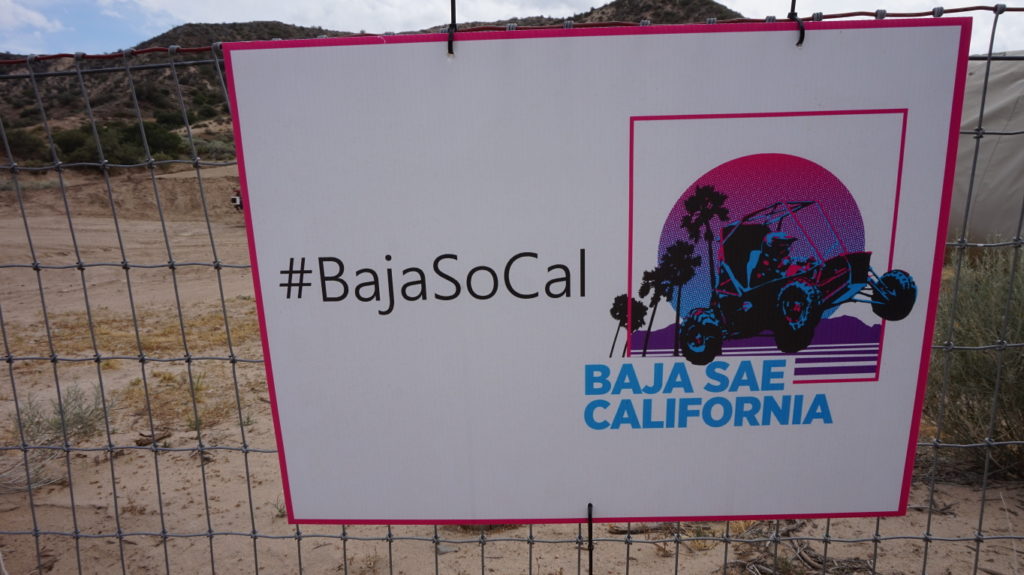
#BajaSoCal, because it is not an official event without a hash tag.
This year marks the 40th anniversary of SAE Baja; however, it is only the first time that I’ve had the privilege of attending an event. I thought I would take this opportunity to reflect on the four-day competition and provide a newbie’s wide-eyed take on the engineering awesomeness involved.
Overview
Before we journey through the specifics of each day, a brief overview will be helpful for those completely unfamiliar with the event. Sponsored by the Society of Automotive Engineers (SAE), Baja challenges students to design and build an off-road buggy and then compete their creation against others made by teams from around the world. The event we attended included teams from the US, Canada, Mexico, India, the United Arab Emirates, South Korea, and China.
Technically, Baja is a series of three competitions held in various regions of the continental United States. The locations for 2016 were: Cookeville, Tennessee; Gorman, California; and, Rochester, New York. Along with the individual winners, an overall champ is crowned based on the combined performance at all three events.
Just getting into one of the competitions can be challenging. Only 100 teams are admitted to each event and online registration occurs simultaneously for all three. The morning that registration opened our students were armed with every electronic device imaginable in order to secure one of those 100 spots. Our preference was to attend the Rochester competition due to its proximity; unfortunately, things did not go according to plan. A dark mood settled on the engineering building that day because our team, the Laurentian University Voyageurs Racing Club (LUVRC), failed to make it into the top 100 spots for any of the competitions. Thankfully, we did make it onto the 50-team waiting lists for all three. California was the first event where we moved off of the waiting list, so off to California we went!
It is hard to convey the countless hours of work that teams put in preparing for a competition. Beyond just the design and manufacturing of the buggy itself, teams are also responsible for submitting design and cost reports that contribute to the overall team score. But rather than dwell on the blood, sweat, tears, and caffeine needed to get to competition, let’s focus on the fun part: the four-day event itself!
Day 1
On paper, Day 1 seems to have a fairly leisurely schedule: arrival, registration, engine check, sales presentation. The reality is that a lot of jockeying for position occurs on this first day that can benefit teams over the remainder of the competition.
Arrival
When we first arrived on site, we were directed to a spot in the paddock that was to be our home for the next few days. It is where we parked our trailer and unloaded our buggy. It served as our base of operations for rest of the competition.
Teams line up really early to be the first in line. The California competition was held at the Quail Canyon Special Events Area. The gates opened at 7am; however, registration only began at 8am. Rumour had it that at least one team was lined up at 2:30am in order to be the first in line. While such behaviour may seem extreme, being the first team, or one of the first few teams, does confer a number of useful advantages.
Engine check
Each team is required to use the same Briggs & Stratton engine in their vehicle. These motors were inspected at the competition to ensure that they had not been modified and to check that the governor was set properly. Because of California’s multi-year drought, there was also a specific requirement for this competition that a spark arrestor be mounted to the engine to keep from accidentally starting a fire.
The main reason teams lined up so early was so that they could quickly unload their buggy and get queued for engine check. This eagerness has little to do with the engine check itself; the process is generally uneventful. However, the first 50 teams for engine check received numbered positions for the technical inspection on Day 2. Given the rigours of tech inspection, having a guaranteed early visit is a huge advantage.
Registration
The first day also required teams to officially register their presence on site. Teams were given the opportunity to provide all the information online and gather the necessary signatures in advance. This greatly simplified and expedited the process.
Registration is also where the meal tickets and free stuff were handed out. You don’t want to miss out on either.
Sales Presentation
The only other significant event on Day 1 is the sales presentation. Select team members give a ten minute presentation on their vehicle and then field about five minutes of questions from the judges. The nominal scenario is this: your team is attempting to sell your design to a group of corporate executives. The focus of the presentation is not so much on the technical merits of the design itself, but rather the economic viability of a hypothetical run of 4000 vehicles. These were closed-door presentations; none of the other teams were able to see or hear what we presented.
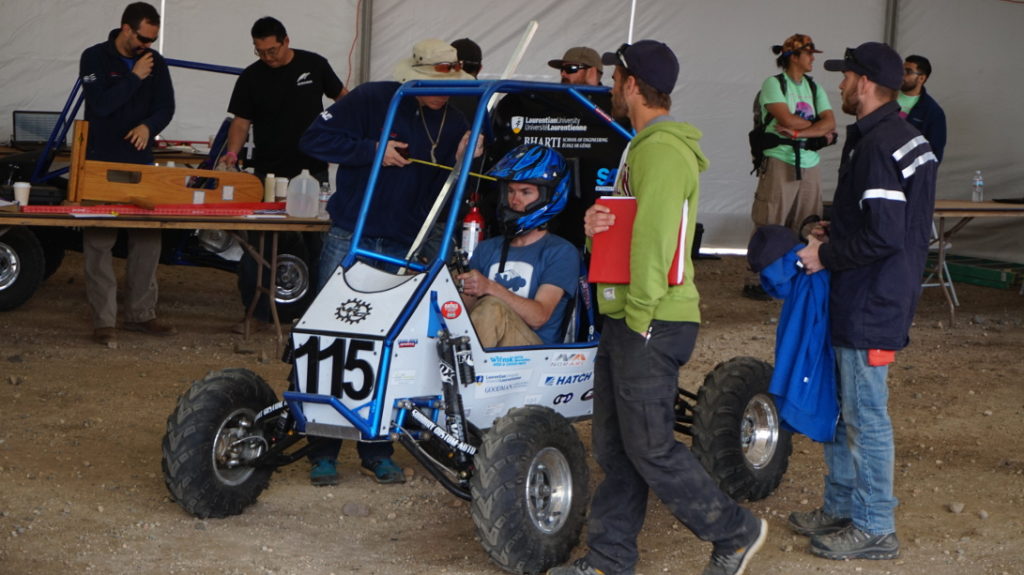
The distances from Justin’s helmet to the roll cage are checked for compliance with the SAE Baja rule book.
Day 2
Although important, the activities of Day 1 were generally laid back. It is mostly unpacking, setting up, and making last minute prep to the buggy. Day 2 was where the competition began in earnest.
Technical inspection
Tech inspection has a well-deserved reputation for heart-break. If you’ve heard only one thing from a Baja veteran, it is probably a horror story about this aspect of the competition. In Harry Potter and the Prisoner of Azkaban, J.K. Rowling wrote of the Dementors that they “are among the foulest creatures that walk this earth. They infest the darkest, filthiest places, they glory in decay and despair, they drain peace, hope, and happiness out of the air around them.” Rumour has it that these creatures were inspired by Rowling’s experience with the tech judges!
I kid. The tech judges are all kind-hearted folks who are volunteering their time to enable students to have a fun and safe competition. They are not trying to keep teams from competing. At the same time, every team would benefit from a healthy respect for tech inspection. The Baja SAE rule book is a sixty-odd page document that covers almost every aspect of the buggy’s design, with most rules targeted at ensuring driver safety and fair competition. The goal of the tech judges is to confirm that those rules are followed. To. The. Letter. Unfortunately, the length of the rule book, and the occasional vagueness of specific sections, makes it easy to overlook or misinterpret individual rules.
The judges will check the design of the frame. They will check the tubing used in the frame. They will check your wiring. They will check your brakes. They will check your kill switch. They will check the grade of bolts you’ve used. They will check… you get the idea. If it is in the rule book, you can expect the judges to check it.
In addition to your vehicle, they also evaluate your drivers. One or more will be selected and asked to sit in the buggy. Since the roll cage must extend certain distances from the driver, those clearances will be measured. Drivers must also be able to exit the vehicle, be on their feet next to it, and do so safely, in under five seconds. Our drivers spent a great deal of time practising to make sure that the could do so when called upon by the judges.
Passing tech inspection on your first attempt is an impressive accomplishment; however, teams usually have to make multiple visits. These return visits are why guaranteed early access to tech is such a highly coveted commodity. Since you don’t know exactly what problems the judges will uncover, you want to give your team as much time as possible to address any problems. This is the reason teams line up at 2:30 in the morning on Day 1.

Those three blue stickers —Briggs & Straton, Passed Tech, and Baja SAE California— indicate a vehicle that has passed the engine check, technical inspection, and the dynamic brake testing. It is ready to compete.
Dynamic Brake test
Tech inspection includes a static break test; however, you cannot participate in any events until you have also passed the dynamic brake test. This is the last technical evaluation.
The test is simple enough. The driver must accelerate the vehicle in a straight line and then slam on the brakes. All four wheels must lock up. There are four judges –one watching each wheel– to ensure that they do.
You get the first sticker for your buggy upon successfully passing the engine check, one for tech inspection, and a third for the brake check. Once you have collected all three stickers, you are able to drive your vehicle through the paddock area, use the practice track, and participate in the dynamic events. The sooner you can get approved, the sooner your team can get started. Unfortunately, technical issues sometimes prevent some teams from reaching this point until late on Day 3.
Design presentation
Each team is also required to give a design presentation to a group of judges. Since these presentations run concurrently with tech inspection, pray that your scheduled time does not arrive just as you are about to enter the inspection area. Your vehicle must be present for the presentations and, if the two conflict, you will have to forfeit your place in the inspection line to attend.
Unlike the sales presentation, which is a more formal event, the design presentation consists mostly of a group of judges grilling team members about the technical aspects of the vehicle. Since multiple groups present simultaneously in the same area, it can be quite noisy and chaotic. The top teams are invited to give presentations at the end of the day for final judging.
Day 3
The various reports (cost and design) and presentations (sales and design) are all considered “static” events. Day 3 is the start of the “dynamic” events. Hopefully, your team has passed tech inspection by this point and your vehicle is ready to roll. If not, you will be scrambling to get approval so that you don’t miss out on any of the events.
Acceleration
The acceleration test is pretty much what you might expect. Upon being given a signal, the driver must accelerate the vehicle over a 100 or 150 foot course. The best time from your two attempts determines your score.
The acceleration event is also noteworthy because of what it means for the following day’s endurance race. Buggies are usually gridded for the start of the race according to the acceleration results. Since the faster cars are placed at the front, there is an advantage to having better accelerations times.
Maneuverability
The maneuverability event is a course that has been laid out with cones. Most of the cones are lying on their sides, pointing in the direction the buggy must travel. Other cones are upright with a small ball placed on top. The driver must navigate through the cones as quickly and carefully as possible. Knocking the balls off one of the upright cones results in a 2 second time penalty. Missing gates or driving off the course also result in penalties or a Did Not Finish (DNF). The better time from two attempts is used to calculate your score.
I'd guess this was everyone's favorite moment from the Suspension & Traction event on Day 3 of #BajaSoCal pic.twitter.com/kw2NnvWxER
— Brent Lievers (@WBLievers) May 22, 2016
Suspension and traction
The Baja buggies need to be able to handle off-road conditions; the suspension and traction event is designed to ensure that they can. One at a time, teams are given the opportunity to navigate through a course filled with challenging terrain: rocks, logs, cross-cuts, hills, and so on. Scores are again given for the fastest times through the course; however, you can be given a red flag for hitting a hay bale or missing a turn along the way. Flagged runs are scored based on distance only.
Hill climb
The fourth dynamic event was the hill climb. Buggies are placed at some point on the slope. From a standing start, they must drive as high up the hill as they can. Teams that make it up the hill are graded on time and those that do not are assessed based on distance travelled.
The hill in California was a steep 300 foot climb known as The Himalaya. This turned out to be our best event and we finished in fifth place. Unfortunately, we did not make it all the way up. Only two teams successfully climbed the hill, and only was successful on both attempts!
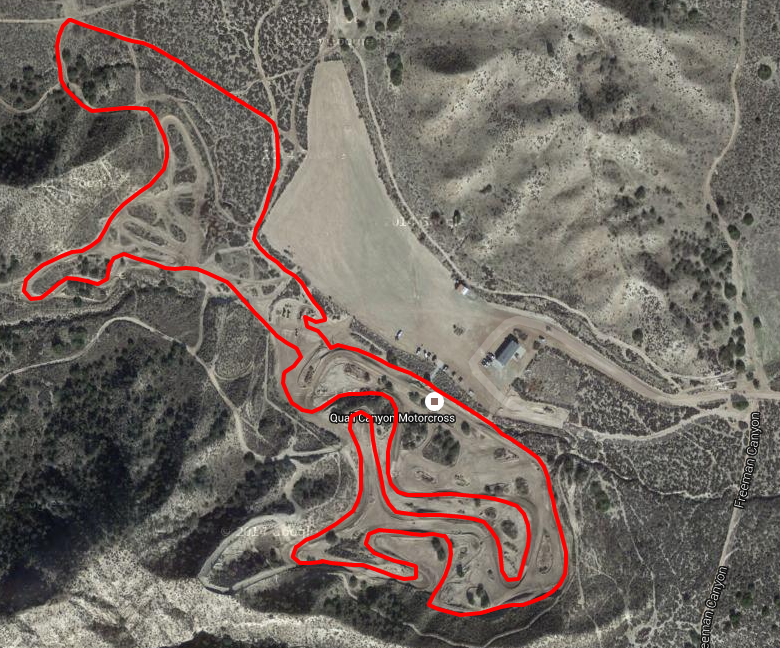
Map of the four-hour endurance race course (created using Google Maps).
Day 4
The last day is almost entirely devoted to the marquis event: the four-hour endurance race.
Endurance event
The objective of the endurance event is to complete as many laps as possible in four hours. While it is simple, it is also very important; the endurance race counts for 400 out of the total 1000 points. Transponders attached to each vehicle track the number of laps and allow the results to be updated in real-time. It makes for a compelling event as you see your team gain or lose ground to the competition.
As shown in the map above, each lap represented about 3 km trip around the course. What the map does not show is the diversity of features that the drivers encountered: straight-away stretches, hill climbs, hair-pin turns, table tops, cross cuts, mud, rock gardens. The course had a little bit of everything. Everyone had the opportunity to walk the track beforehand which allowed you to appreciate what the drivers and their buggies would experience during the race.
Teams were gridded according to the results of the acceleration event with the fastest teams placed at the front of the pack. Once the race started, it was simply a matter of completing as many laps as possible. Each team has the option to pit for refueling, repairs, or swapping drivers. Obviously, each time you came off the course represented lost time where you could not complete laps.
Automotive carnage is not uncommon during the endurance race. Buggies had to be towed off the course due to a variety of mechanical problems, some minor and others severe. Teams were often scrambling trying to make repairs and get their vehicle running again as quickly as possible. Race officials give each buggy a quick technical inspection before it is allowed back on the course.
The top teams in California were able to complete 43 laps in the four hours. Others teams completed as few a two or, in some cases, zero. The average and median of those who completed at least one lap was 24.
Four hour endurance race on Day 4. Keep your eye on #LUVRC car 115. pic.twitter.com/mhLvP1EHt6
— Brent Lievers (@WBLievers) May 23, 2016
Closing ceremonies
Shortly after the completion of the endurance event are the banquet and closing ceremonies. The latter is a relatively low-key affair where awards are handed out to the top three finishers in each of the static and dynamic events, as well as the top overall finishers. The comments made during the ceremony, particularly with respect to the design winners, give a good indication of the level of design and engineering required to be among the top schools.
Conclusion
My first Baja competition was an eye-opening experience. Getting to witness the events, the designs, and the level of competition, left me with a deeper appreciation of what a dedicated team of engineering students can accomplish. It was pretty fun too!
The California event marked Baja’s return to California after an almost 25 year absence. My understanding is that Baja SAE will be returning to the same site next year. So if what I’ve described sounds like an event in which you want to become involved, join the team and get ready for 2017!

